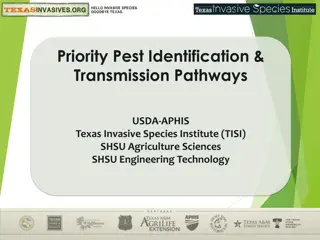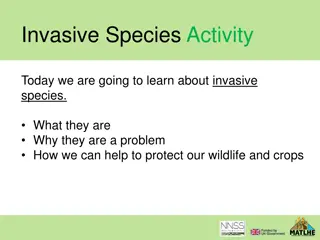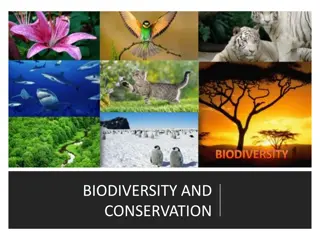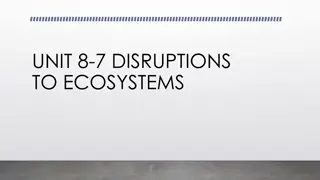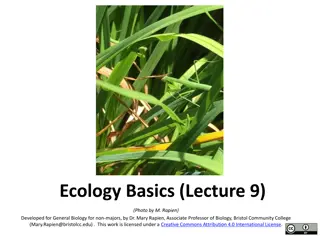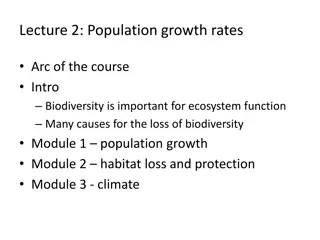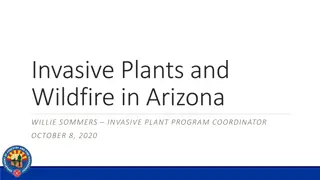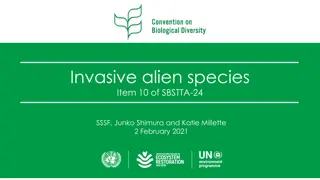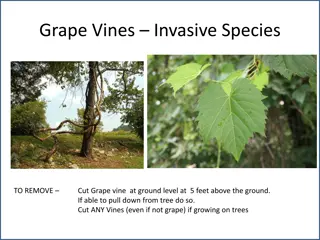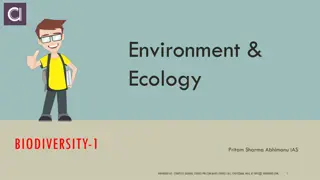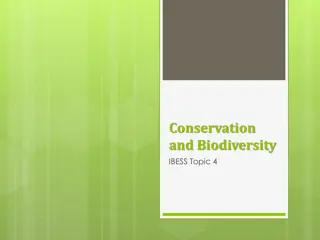The Impact of Invasive Species on Biodiversity and Ecosystems
The introduction of foreign species can have detrimental effects on biodiversity, ecosystems, and even humans. Invasive species like the Sea Lamprey and Burmese Python disrupt natural habitats, leading to a decline in biodiversity and posing risks to native species and human populations. However, they can also help solve preexisting problems, as seen with Dung Beetles and Kudzu. Understanding the importance of biodiversity and implementing solutions such as stricter laws and hunting rewards are crucial steps in managing invasive species effectively.
Download Presentation

Please find below an Image/Link to download the presentation.
The content on the website is provided AS IS for your information and personal use only. It may not be sold, licensed, or shared on other websites without obtaining consent from the author. Download presentation by click this link. If you encounter any issues during the download, it is possible that the publisher has removed the file from their server.
E N D
Presentation Transcript
Alien Species V.S.
Is the introduction of foreign species detrimental? CANDIDATE# 2285
Plant Foreign Species Animal Fungus
Thesis *Solve preexisting problems *Less biodiversity *Over population
Less Biodiversity Example 1 (Sea Lamprey Quebec, 2016) (Sea Lamprey Quebec, 2016)
Less Biodiversity Example 2 Montgomery, H. (1999). Food Webs and the Introduction of Foreign Species. Retrieved April 20, 2016, from https://www.utdallas.edu/scimathed/resources/Melville/treesnake/Survivor.htm
Dangerous to Humans Example 1 Interesting fact: Burmese python hatchlings are 18 long and the longest one captured in south Florida was 18 8 . (Python Patrol, 2016) (Burmese Pythons, 2016) (Burmese Pythons, 2016)
Gets rid of Preexisting Problems Example 1 (Dung Beetles, 2016) (Dung Beetles, 2016)
Gets rid of Preexisting Problems Example 2 (Kudzu, 2016)
Conclusion Invasive Species
Solution Tax s on Pets Stricter Laws More Hunting Rewards Less invasive Species
References Edwards, P. (2007, July). Overview of Introduced Dung Beetles in Australia. Retrieved April 20, 2016, from http://www.landcareonline.com.au/wp-content/uploads/2010/10/Part-Two-Section-1-Overview-of-Introduced-Dung-Beetles-in- Australia.pdf Invasive species. (2016). Retrieved April 13, 2016, from https://en.wikipedia.org/wiki/Invasive_species Montgomery, H. (1999). Food Webs and the Introduction of Foreign Species. Retrieved April 20, 2016, from https://www.utdallas.edu/scimathed/resources/Melville/treesnake/Survivor.htm Quebec Biodiversity Website. (2016). Impacts on Biodiversity. Retrieved April 14, 2016, from http://redpath- museum.mcgill.ca/Qbp/3.Conservation/impacts.htm Rafferty, J. P. (2015, November 25). Invasive Species. Retrieved April 20, 2016, from http://www.britannica.com/science/invasive-species Strayer, D. L. (2013, March 31). Invasive species pose serious danger to humans. Retrieved April 21, 2016, from http://www.caryinstitute.org/newsroom/invasive-species-pose-serious-danger-humans The Human Society of the United States. (2012). Constrictor snake attacks. Retrieved April 20, 2016, from www.humanesociety.org/.../captive/constrictor-snake-attacks.pdf Wild Florida - a series from WPBT Channel 2. (2016). Retrieved April 15, 2016, from http://www.wildflorida.tv/exotics/funfacts.html WWF Global. (2016). How does Biodiversity loss affect me and everyone else? Retrieved April 20, 2016, from http://wwf.panda.org/about_our_earth/biodiversity/biodiversity_and_you/


